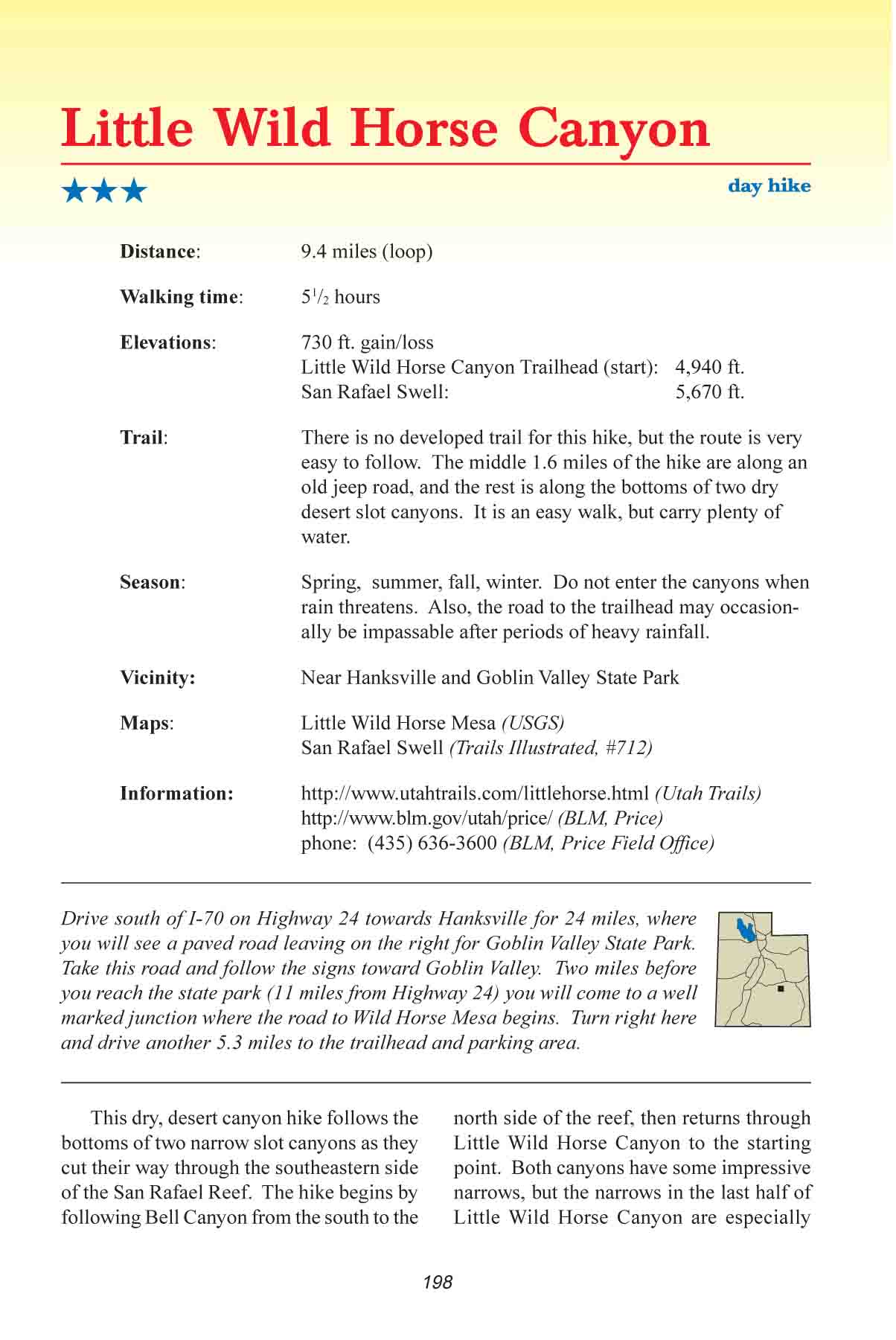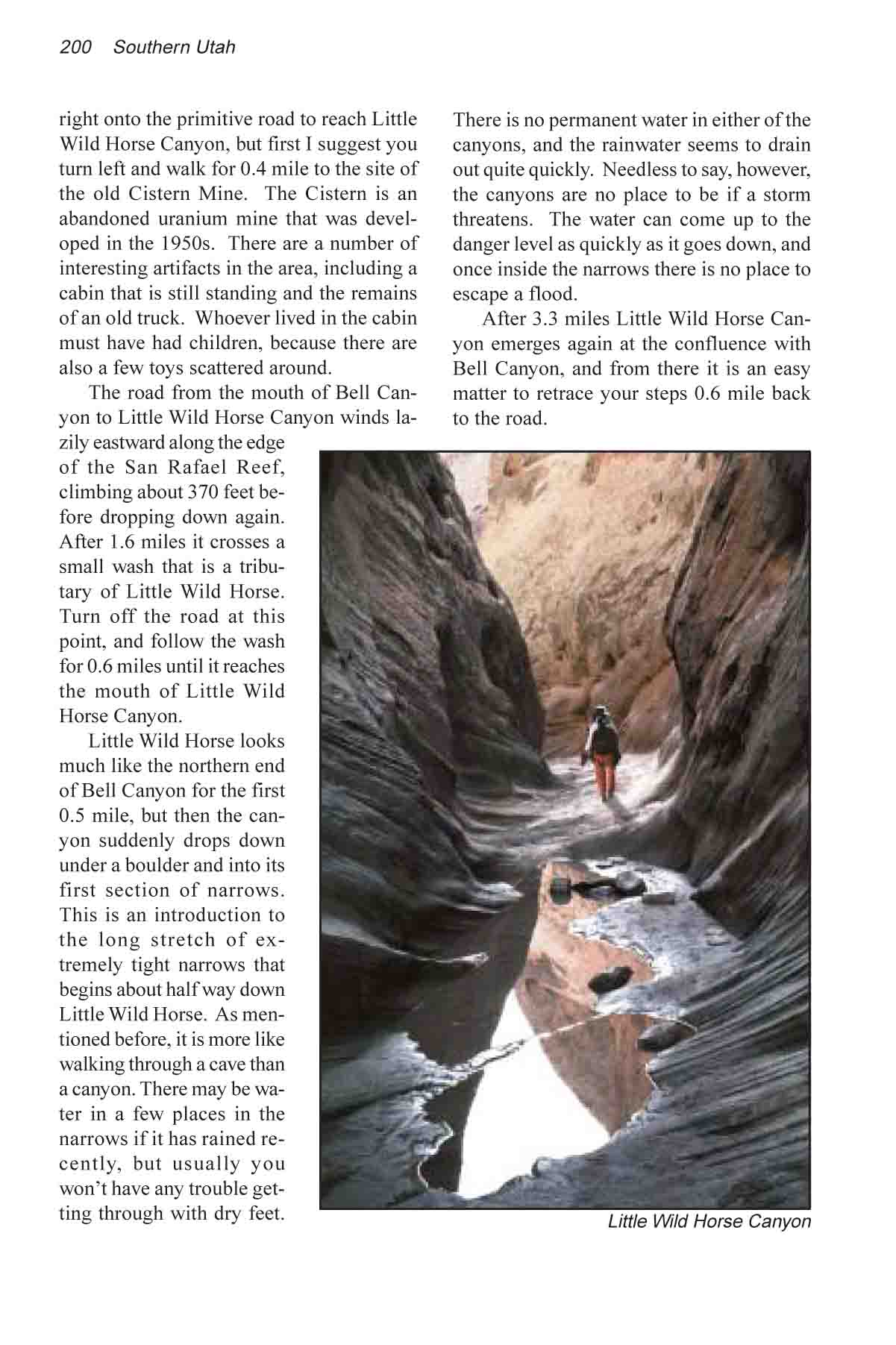|
Links to other sites:
Ordering books & Maps
Comments about this site or our book:

|
This dry, desert canyon hike
follows the bottoms of two narrow slot canyons as they cut their
way through the southeastern side of the San Rafael Reef. The
hike begins by following Bell Canyon from the south to the north
side of the reef, then returns through Little Wild Horse Canyon
to the starting point. Both canyons have some impressive narrows,
but the narrows in the last half of Little Wild Horse Canyon
are especially noteworthy. In one section the canyon meanders
along for well over a mile with the distance between the sides
rarely exceeding five feet. Walking down Little Wild Horse Canyon
often feels more like exploring a cave that hiking in the desert.
Children seem to get a particular thrill out of walking in the
narrow passages, and this relatively easy hike is a good one
for a family outing.
From the car parking area, follow
the sandy bottom of Little Wild Horse Wash northward towards
the San Rafael Reef. It is possible to drive up the wash and
save ten minutes of footwork, but the stream bed is very narrow
and sandy. I suggest you save wear and tear on your car and the
environment by beginning your hike at the road. After 0.4 mile
you will see a small sign on the left side of the wash marking
the beginning of the Crack Canyon Wilderness Study Area, beyond
which vehicles are not allowed. After another few hundred yards
the flat streambed is interrupted by a small dry waterfall. The
easiest way around this obstacle is to climb slightly up the
left side of the canyon and drop back to the bottom a short distance
later at the confluence of Bell and Little Wild Horse Canyons.
When you reach the confluence bear left into Bell Canyon.
The next section of the hike is
an easy walk up the flat, sandy bottom of Bell Canyon. The canyon
is quite narrow at first, but it steadily widens, finally breaking
out of the San Rafael Reef and onto the San Rafael Swell some
1.9 miles later.
As you leave the canyon watch carefully
for a jeep road coming into the streambed from the right. If
you walk more than 0.1 or 0.2 mile from the mouth of the Canyon
you have missed the road. You will have to turn right onto this
jeep road to reach Little Wild Horse Canyon. The road winds gently
eastward along the base of the San Rafael Reef, climbing about
370 feet before dropping down again. After 1.6 miles it crosses
a smaller wash which is a tributary of Little Wild Horse. Turn
off the road at this point, and follow the smaller wash for 0.6
miles until it joins Little Wild Horse Canyon.
Little Wild Horse looks much like
the end of Bell Canyon for the first 0.5 mile, but then the canyon
suddenly drops down under a boulder and into its first section
of narrows. This is an introduction to the long stretch of extremely
tight narrows that begins about half way down Little Wild Horse.
As mentioned before, it is more like walking through a cave than
a canyon. There may be water in a few places in the narrows if
it has rained recently, but usually you won’t have any trouble
getting through with dry feet. There is no permanent water in
either of the canyons, and the rainwater seems to drain out quite
quickly. Needless to say, however, the canyons are no place to
be if a storm threatens. The water can come up to the danger
level as quickly as it goes down, and once inside the narrows
there is no place to escape a flood.
After 3.3 miles Little Wild Horse
Canyon emerges again at the confluence with Bell Canyon, and
from there it is an easy matter to retrace your steps the 0.6
mile back to the road. |

